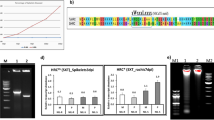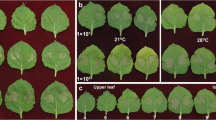Abstract
Harpin proteins encoded by hrp genes are bacterial protein elicitors that can stimulate hypersensitive response (HR) in non-host plants. HR-related pathogen resistance involves a complex form of programmed cell death (PCD). It is increasingly viewed as a key component of the hypersensitive disease response of plants. Currently, the evidence of harpin proteins-induced PCD is deficient though it exhibits phenotypic parallels with HR, and the mechanism of harpin proteins-induced PCD is not well understood. In this study, we demonstrate that harpinXoo protein from Xanthomonas oryzae pv. oryzae of rice bacterial blight expressed and isolated from bacterial cells acted as an agent to induce PCD in infiltrated tobacco plants. Treatment of tobacco leaves with harpinXoo induced typical PCD-related morphological and biochemical changes including cell shrinkage and nuclear DNA degradation. We further analyzed the expression of several genes in signal transduction pathway of PCD in tobacco plants by real-time qRT-PCR analysis using EF-1α as an endogenous control. Our results showed that the expression of NtDAD1 was down-regulated and the expression of BI-1, tpa1 and aox1 was up-regulated following the infiltration of harpinXoo into tobacco leaves. Our data suggest that harpinXoo can induce PCD with the coordination of PCD-related genes in infiltrated tobacco leaves, providing evidence to further investigate the signal transduction pathways of HR and PCD.




Similar content being viewed by others
Abbreviations
- PCD:
-
Programmed cell death
- HR:
-
Hypersensitive response
References
Abreu ME, Munné-Bosch S (2009) Salicylic acid deficiency in NahG transgenic lines and sid2 mutants increases seed yield in the annual plant Arabidopsis thaliana. J Exp Bot 60:1261–1271
Eason JR, Pinkney TT, Johnston JW (2002) DNA fragmentation and nuclear degradation during harvest-induced senescence of asparagus spears. Postharvest Biol Technol 26:231–235
Enyedi AJ, Yalpani N, Silverman P et al (1992) Localization, conjugation, and function of salicylic acid in tobacco during the hypersensitive reaction to tobacco mosaic virus. Proc Natl Acad Sci USA 89:2480–2484
Gopalan S (2008) Reversal of an immunity associated plant cell death program by the growth regulator auxin. BMC Res Notes 1:126
Gunawardena AH, Pearce DM, Jackson MB et al (2001) Characterisation of programmed cell death during aerenchyma formation induced by ethylene or hypoxia in roots of maize (Zea mays L.). Planta 212:205–214
Hatsugai N, Kuroyanagi M, Yamada K et al (2004) A plant vacuolar protease, VPE, mediates virus-induced hypersensitive cell death. Science 305:855–858
Heath MC (1998) Apoptosis, programmed cell death and the hypersensitive response. Eur J Plant Pathol 104:117–124
Heath MC (2000) Hypersensitive response-related death. Plant Mol Biol 44:321–334
Hückelhoven R (2004) Bax Inhibitor-1, an ancient cell death suppressor in animals and plants with prokaryotic relatives. Apoptosis 9:299–307
Kacprzyk J, Devine A, McCabe PF (2014) The root hair assay facilitates the use of genetic and pharmacological tools in order to dissect multiple signalling pathways that lead to programmed cell death. PLoS ONE 9:e94898. doi:10.1371/journal.pone.0094898
Kelleher DJ, Gilmore R (1997) DAD1, the defender against apoptotic cell death, is a subunit of the mammalian oligosaccharyltransferase. Proc Natl Acad Sci USA 94:4994–4999
Kombrink E, Somssich IE (1995) Defense responses of plants to pathogens. Adv Bot Res 21:2–33
Lam E (2004) Controlled cell death, plant survival and development. Nat Rev Mol Cell Biol 5:305–315
Lindgren PB, Peet RC, Panopoulos NJ (1986) Gene cluster of Pseudomonas syringae pv. “phaseolicola” controls pathogenicity of bean plants and hypersensitivity of nonhost plants. J Bacteriol 168:512–522
Liu AX, Li DC, Wang JS et al (2005) HCD in tobacco induced by harpinXoo showing characteristics of PCD. Sci Agric Sin 38:2446–2450
Mark D, Paul F (2011) Mitochondrial regulation of plant programmed cell death. Plant Mitochondria 17:439–465
Miao WG, Wang XB, Li M et al (2010) Genetic transformation of cotton with a harpin-encoding gene hpa Xoo confers an enhanced defense response against different pathogens through a priming mechanism. BMC Plant Biol 10:67
Millenaar FF, Lambers H (2003) The alternative oxidase: in vivo regulation and function. Plant Biol 5:2–15
Nakashima T, Sekiguchi T, Kuraoka A et al (1993) Molecular cloning of a human cDNA encoding a novel protein, DAD1, whose defect causes apoptotic cell death in hamster BHK21 cells. Mol Cell Biol 13:6367–6374
Plaxton WC, Podesta FE (2006) The functional organization and control of plant respiration. Crit Rev Plant Sci 25:159–198
Robert-Seilaniantz A, Grant M, Jones JD (2011) Hormone crosstalk in plant disease and defense: more than just jasmonate-salicylate antagonism. Ann Rev Phytopathol 49:317–343
Sanchez P, de Torres Zabala M, Grant M (2000) AtBI-1, a plant homologue of Bax inhibitor-1, suppresses Bax-induced cell death in yeast and is rapidly up-regulated during wounding and pathogen challenge. Plant J 21:393–399
Sang S, Li X, Gao R et al (2012) Apoplastic and cytoplasmic location of harpin protein Hpa1Xoo plays different roles in H2O2 generation and pathogen resistance in Arabidopsis. Plant Mol Biol 79:375–391
Song J, Gong XC, Miao WG et al (2014) Indole-3-acetic acid reverses the harpin-induced hypersensitive response and alters the expression of hypersensitive-response-related genes in tobacco. Biotechnol Lett 36:1043–1048
Stakman EC (1915) Relation between Puccinia graminis and plants highly resistant to its attack. J Agric Res 4:193–299
Tampakaki AP, Skandalis N, Gazi AD et al (2010) Playing the “Harp”: evolution of our understanding of hrp/hrc genes. Annu Rev Phytopathol 48:347–370
Tanaka N, Che FS, Watanabe N et al (2003) Flagellin from an incompatible strain of Acidovorax avenae mediates H2O2 generation accompanying hypersensitive cell death and expression of PAL, Cht-1, and PBZ1, but not of Lox in rice. Mol Plant Microbe Interact 16:422–428
van der Kop DAM, Ruys G, Dees D et al (2003) Expression of defender against apoptotic death (DAD-1) in Iris and Dianthus petals. Physiol Plant 117:256–263
van Doorn WG, Beers EP, Dangl JL et al (2011) Morphological classification of plant cell deaths. Cell Death Diff 18:1241–1246
Wagstaff C, Malcolm P, Rafiq A et al (2003) Programmed cell death (PCD) processes begin extremely early in Alstroemeria petal senescence. New Phytol 160:49–59
Wei ZM, Laby RJ, Zumoff CH et al (1992) Harpin, elicitor of the hypersensitive response produced by the plant pathogen Erwinia amylovora. Science 257:85–88
Wojciechowska M, Olszewska MJ (2003) Endosperm degradation during seed development of Echinocystis lobata (Cucurbitaceae) as a manifestation of programmed cell death (PCD) in plants. Folia Histochem Cytobiol 41:41–50
Yamada T, Ichimura K, van Doorn WG (2006) DNA degradation and nuclear degeneration during programmed cell death in petals of Antirrhinum, Argyranthemum, and Petunia. J Exp Bot 14:3543–3552
Acknowledgments
This work was supported by Grants from National Natural Science Foundation of China (31160359, 31360029), Doctoral Fund of Ministry of Education (20124601110004, 20104601110004) and Research and start-up capital of Hainan University (kyqd1006).
Author information
Authors and Affiliations
Corresponding author
Ethics declarations
Conflict of interest
We declare that we have no financial and personal relationships with other people or organizations that can inappropriately influence our work, there is no professional or other personal interest of any nature or kind in any product, service and/or company that could be construed as influencing the position presented in, or the review of, the manuscript entitled, “HarpinXoo-induced hypersensitive response shares the characteristics of programmed cell death and alters the expression of programmed cell death-related genes in tobacco”.
Additional information
Linlin Xie and Yue Liu contributed equally to this work and are regarded as joint first authors.
Rights and permissions
About this article
Cite this article
Xie, L., Liu, Y., Wang, H. et al. Characterization of harpinXoo induced hypersensitive responses in non host plant, tobacco. J. Plant Biochem. Biotechnol. 26, 73–79 (2017). https://doi.org/10.1007/s13562-016-0363-9
Received:
Accepted:
Published:
Issue Date:
DOI: https://doi.org/10.1007/s13562-016-0363-9




